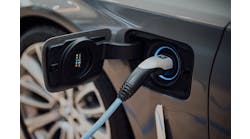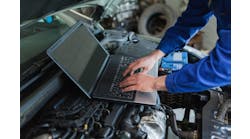In 2015, the International Automotive Technician’s Network (iATN) celebrated its 20th anniversary. Throughout that time, the network has gone from a few emails exchanged between a group of technicians to the largest network of repair professionals in the world, with more than 83,000 members from 160 countries sharing technical and managerial knowledge. Network president Scott Brown has been with the company since its inception and has had a firsthand look at the importance of vehicle information and how that role has changed over the years.
Brown, who is also an independent shop owner, recently sat down with Ratchet+Wrench to discuss the place of data in the industry, both past and present.
It’s no secret that vehicles are getting more complex and harder to repair. What role does vehicle data hold in today’s industry?
Vehicle repair information and system knowledge is a huge asset. The way that I see it, from the technician’s perspective, when a car is broken or exhibiting strange symptoms, it needs to be analyzed, properly diagnosed and the proper parts or services need to be applied. When the vehicle is manufactured, engineering teams are set up to write test routines in order to help a service tech in the event of a fault. The vehicles today—the vehicle fleet from 2007 on—are very complex. All the scenarios cannot be completely defined in a test plan in a service manual. So that’s where system knowledge, theory and application are critical. Not only does the tech need to have access to the proper service information, but they need to have a clear understanding of how these systems operate and, when they don’t operate properly, what the anomalies represent.
“I only see it becoming more demanding as we move forward because the layers of technology are making the vehicle very complex.”
—Scott Brown, president, iATN
We have an explosion of data available on the vehicle today through the diagnostic access port. To be able to interpret that data properly is crucial. In some cases, the service manuals don’t completely cover that. We do see a lot of guys talking about additional best practices on analyzing data and how to get that computer to tell you what the pain points are, what are the corrections being applied and why would those corrections need to be applied. That’s where the importance of service info is crucial but the supplemental core knowledge the tech needs is equally important so that folks can address the vehicle problems at an intelligent level. Otherwise, it’s going to result in an unhappy customer and a repeat failure. I only see it becoming more demanding as we move forward because the layers of technology are making the vehicle very complex.
With the changes in vehicles today, have the challenges that a network like iATN faces changed, too?
One of the challenges that we see is that although there is a ton of that exercise going on where guys are learning from each other and sharing info, some folks need it to be in a more structured format, such as a syllabus or curriculum. We don’t really have a system like that in place. That’s something that we would probably like to explore down the road some day.
The other issue is that vehicles run so well today that even when there is a fault, a lot of times, the customers will see the light come on and not notice anything wrong with their vehicle’s performance. What do they do? They keep driving it. Then there may be another fault that occurs and it may exhibit some weirdness but the light didn’t get brighter. So there could be multiple fault instances recorded in the vehicle communicated through that one light. The consumer will arrive at a service center with multiple faults and the tech is challenged with prioritizing. That’s another challenge in itself: addressing those vehicle problems that weren’t brought to the service dealer’s attention immediately upon failure. Without the right strategy and knowledge and service info, it’s a rough road for a shop to try to address that professionally.
What do you see as the role of service information providers today in helping shops address some of those issues you mentioned, especially as they become more important?
The role has grown more complex. I have seen some of the service providers, such as the OE, using technologies like active wiring diagrams. There are some Asian or Korean manufacturers out there that have realized that there is more to it than this flat, 1-D diagram. We can make this active and help the tech understand power flow and operation. In that case—and I’ve seen some of the actual delivery of this information—it’s very powerful. The tech can turn the key on, see where power should be, exercise components like switches, and get clear power flow. Now the tech has a deeper understanding of what to expect or how to test the system. Again, sometimes when things are written out, the reading and comprehension that’s needed can be challenging. Even when it’s written well, it’s hard to interpret or translate to an actual test routine.
The other thing that I can see changing is that typically in years past, we would have volumes of printed service manuals going back decades. You’d go to the table of contents and you’d go to the engine section and then go to the fuel specifications. That makes it challenging to jump back and forth and find information. Today, you may need information that is stored in different areas. The digital delivery of information can be done way more effectively through the contextual delivery. So as the tech is looking up a particular fault, all of the contextual information needed can be assembled and delivered in one location, where the tech can grab it as he needs it. I see a lot of OEMs start to do that. Our sister company Identifix has been working hard to do this. They studied this tremendously and understand the contextual part of this is an efficiency factor. If you can deliver the service information in a very clean, easy-to-understand format with all of the data pretty much in front of you, you’re going to trim some of that time down.
How will iATN continue to address those changes and challenges you discussed as it moves forward?
As we evolve and change, we are realizing that the technology and the way people access this information is really changing, especially when it comes to mobile devices. We just released our first iteration of the mobile platform to access iATN. So, delivery of the data, contextually and relationally, is what we’re focused on. As folks are looking for a particular item, we basically bring them all the information from all segments of iATN so they don’t miss anything.
Second, the ability to share rich data and content from an automobile, such as data that’s being streamed off the vehicle from an aftermarket scan tool, and move that data right into a discussion and allow it to be discussed. We have those channels in place today and we want to continue to make that even easier for users. There’s a lot of learning going on when people can talk about a particular problem on the vehicle and people are participating and learning from that rich experience. That sort of activity is very powerful. It’s a method that you simply don’t get in a classroom unless the instructor takes a case study and presents it in the classroom environment. Moving forward, our goals are to streamline that process.



